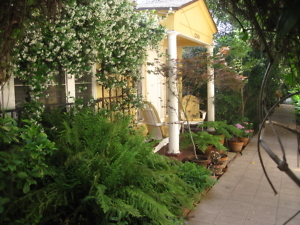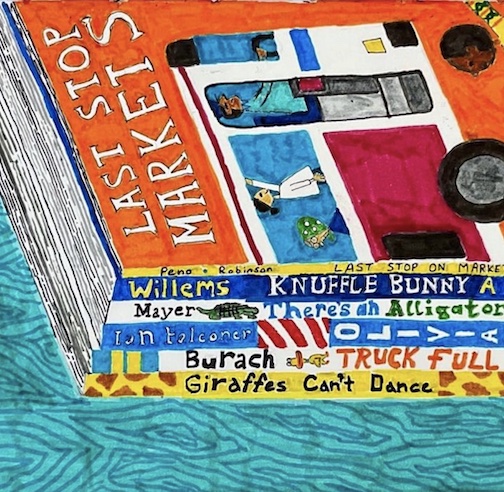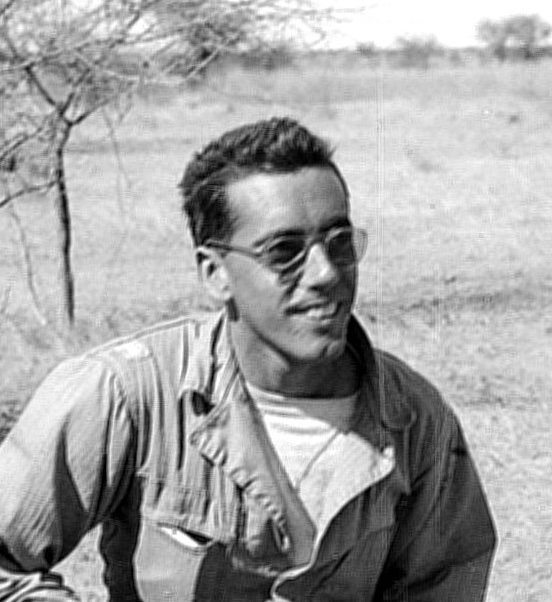Dry Shade
Sometimes a plant—and a person—can thrive in even inhospitable conditions
It was the camellia that made me weep. That sentence makes the entire sentiment suspect, as though I were straining for operatic melodrama. But it’s true. Of all the details about my life in Los Angeles that might flood me with nostalgia, only one plant almost brought me to my knees. Scrolling through my phone’s gallery, I had stumbled onto a picture of the chandleri elegans camellia, the first plant I put into the ground after I moved into the bungalow at 7284 ¼ Fountain Avenue in April 1995. The picture is dated April 1, 2016, the day I moved to Nashville.
 I almost missed the chance to live on Fountain Avenue. A year and a half earlier, fervent with the kind of righteous indignation that’s particular to an entitled twenty-three-year-old, I had quit my copyediting job at The Advocate after a dispute with the new publisher. I believed my destiny lay in New York, but once there I spent all my time in two boxes—the under-lit basement of the tiny but very chi-chi antiquities gallery where I catalogued objects smuggled out of ancient Mediterranean and Chinese archeological sites; and the equally small, Chelsea-adjacent studio from which I could watch eight-year-olds being trained as drug runners on the front steps of the project across the street.
I almost missed the chance to live on Fountain Avenue. A year and a half earlier, fervent with the kind of righteous indignation that’s particular to an entitled twenty-three-year-old, I had quit my copyediting job at The Advocate after a dispute with the new publisher. I believed my destiny lay in New York, but once there I spent all my time in two boxes—the under-lit basement of the tiny but very chi-chi antiquities gallery where I catalogued objects smuggled out of ancient Mediterranean and Chinese archeological sites; and the equally small, Chelsea-adjacent studio from which I could watch eight-year-olds being trained as drug runners on the front steps of the project across the street.
The antiquities dealer could sense I was unhappy in my basement box, so he sent me to Paris to manage the gallery’s booth at an antiquities show and offered me a hefty commission on any piece I sold there. An elderly French lady fell in love with a small marble goddess from third-century BC Greece in uncertain repair; I sold the statue for $175,000 and used my commission to quit the gallery and move straight back to L.A.
After two weeks of driving from one decrepit place to another in a fruitless search for a place to live, I set off one day for Beachwood Canyon to sign the lease on a bland and noisy one-bedroom. It faced the street and the steady traffic of determined tourists eager to see the Hollywood sign, but it wasn’t terrible, and I could afford it. On the way, I noticed a For Rent sign on an iron gate right on Fountain. Sure it would once again be a waste of time, I pulled over anyway.
I opened the gate, and there was the quintessential image of Los Angeles living: two rows of craftsman bungalows, all painted a bright yellow, all with white columns facing a central paved walkway. Large trees—ficuses and rubber trees, the kind of greenery everyone outside California eventually kills as house plants—coated the complex in rich shade. It was early morning, so the almost cloying sweetness of night-blooming jasmine still wafted in intermittent currents. This was the opposite of box living; it was a subtropical paradise.
7284 ¼ was the second door on the left. It shared a wall with 7284, the other half of the bungalow. In front, someone had stuck a rubber tree branch into a small bed of dried claypan, apparently hoping it would take root. It didn’t.
The sharp, acrid smell of smoke hit me just inside the front door. Perhaps someone had barbecued nearby? The door opened directly into the living room, which though tiny contained one remarkable feature: a disproportionately large potbellied stove painted to look like a Holstein cow. Bright white with big black splotches, the cow was wired to a thermostat on the wall behind it. This was the apartment’s only source of heat.
The minuscule kitchen had one winning feature: a built-in breakfast nook with two benches around a table that once upon a time, before successive tenants had frozen the hinges in layers of paint, could swing up and out of the way.
The bedroom was likewise small, but the side facing the walkway consisted almost entirely of an expanse of louvered-pane windows, popular in this warm climate in the days before anyone took the concept of insulation very seriously. The bathroom was tragic: torn linoleum, mildew stains on the ceiling, one bare bulb over the mirror. The bathtub tilted toward the wall at a 30-degree angle.
The manager, a personal trainer with the easy demeanor of a gay Tom Selleck, startled me when he suddenly appeared in the doorway. He must have seen horror etched on my face: “It’s $695 a month,” he said, even before introducing himself. “And it’s rent-controlled.”
I froze. At that price, it would rent very quickly. But 7284 ¼ was not exactly welcoming. When I asked Tom Selleck about the smell of smoke, he told me the previous tenant had set the place on fire when she received her eviction notice. And the louvered windows would make it impossible for me to install a window a/c unit, which would make September, traditionally L.A.’s warmest month, close to unbearable. When I turned around to take one last look, I saw that the entire interior frame of the front door crawled with cockroaches. “They’re just here because it’s empty,” Tom said.
Still it was $50 a month cheaper and significantly more picturesque than the noisy Beachwood apartment. Given that I was doing freelance script reading and research for a local theater company, every penny I saved was crucial. Surely I’d be able to transform the place, I thought, play off the antique 1924 vibe while injecting my own personality, making it humble but cool. So I signed a lease right there and then.
The first thing I did when I moved in was spray Raid all over the front door. The second: paint the potbellied stove black. Embracing the verdant-hideaway feel of the courtyard, I also drove to Sunset Nursery in Silver Lake and bought a plant that books had told me would do well in partial shade: a camellia. Pink ruffled blossoms with streaks of white against elegant, waxy, dark-green leaves.
I tried to dig a hole with a shovel, but half an hour later I’d made no more than a two-inch dent in that hard-as-granite claypan. So I borrowed a pick-axe from a neighbor and hacked at the dirt for hours, mixing in bag after bag of soil amendment. At the end of the day, although I still wasn’t confident something could take root there, I planted the camellia. This was a new beginning for both of us.
Soon the theater hired me as an associate in its literary department, and eventually—eighteen years, two bosses, and three title changes later—I became its director of new-play development. Over two decades, I learned how to create safe spaces in which many of the country’s best playwrights could explore and hone their stories with the help of key collaborators, including actors and directors.
In all those years, however, the bungalow at 7284 ¼ never became significantly more hospitable. That’s the flip side of rent control: when things break down, the landlord might slap a Band-Aid on the problem. Or not even a Band-Aid: the generic adhesive-bandage equivalent. The bathtub teetered ever closer toward the back alley. I couldn’t get renters’ insurance because the potbellied stove had been illegally installed and was therefore a fire hazard. When all was said and done, when its initial charms were revealed to be liabilities, the bungalow was yet another box. And at 432 square feet, it was even smaller than the one I’d left in New York.
 But it was what happened right outside the bungalow that bound me to the place. Once the camellia was in the ground, I started welcoming more plants into the newly tilled bed in front of my house. I spent a week eradicating an impenetrable bamboo thicket between my place and the bungalow at 7284 ½, loaded up my Subaru twice with dozens of 50-pound bags of gravel, and created a little side garden where over the years an array of plants took up residence in a small army of pots. Because my garden was not an easy garden—the aforementioned rock-hard clay, the dry shade, the many times everything had to be dug up because the ninety-year-old water and sewage pipes had given up the ghost—each plant that survived grew to have a story.
But it was what happened right outside the bungalow that bound me to the place. Once the camellia was in the ground, I started welcoming more plants into the newly tilled bed in front of my house. I spent a week eradicating an impenetrable bamboo thicket between my place and the bungalow at 7284 ½, loaded up my Subaru twice with dozens of 50-pound bags of gravel, and created a little side garden where over the years an array of plants took up residence in a small army of pots. Because my garden was not an easy garden—the aforementioned rock-hard clay, the dry shade, the many times everything had to be dug up because the ninety-year-old water and sewage pipes had given up the ghost—each plant that survived grew to have a story.
There were the two star jasmines that I trained up the lattice I installed around my bedroom window. Starting in June, the profusion of tiny blossoms spilled the smell of summer through my bungalow night and day. Ten years later, I looked out the bedroom window to find that hummingbirds had built a nest in the hanging U of one of the vines. The nest was directly at eye level, only two inches at most separating us, and if I stood very still, the birds didn’t object to my presence. I oversaw the rearing of two sets of chicks over two years, until a winter storm knocked the nest down.
Mahogany ferns struggled for two years in the front bed until I thought they might be happier in pots in the side garden. I was right. They were never particularly beautiful, more workmanlike than their feathery and exotic counterparts, but we had figured out how to thrive for the long haul, they and I, and that felt good.
The Brazilian plume plants, justicia carnea, surely did not have enough sun in my garden to grow. I saw them at the Hollywood Farmers’ Market and fell in love. How could I not? They were the Gayest Plants I Could Possibly Buy. If you were to string their blossoms together, you’d create a feather boa that even the most imperial of drag queens would covet. Plume plants require at least two hours of direct sunlight to flourish. “What about an hour or so?” I asked the indifferent woman behind the counter, as though I were negotiating some personal post-fatal-diagnosis probabilities. And they did just fine in an hour of direct sunlight a day. By the time I left, the many cuttings I’d taken from the original two plants had grown into mature specimens whose flowers festooned one small corner of my garden.
So why would a photo of the camellia, of all the other verdant stories in my little garden, bring me to tears? I’m tempted to resort to the hoary metaphors that bind humans and greenery, adages that rely on root imagery and notions of nurturing, but I think the basic facts about the plant will suffice.
It grew excruciatingly slowly. After twenty-one years, it was barely two feet taller and one foot wider than when I planted it. It gently proffered its blooms on schedule starting in December, but for several years most of the buds fell off with fungal rot before they could open. It didn’t ask for more than a couple of doses of acid plant food per year; it was showy for barely a month a year; it couldn’t even stand up on its own without the metal stake to which it was attached. But it persisted. It took its time. It was dependable.
In that photo on my phone, I saw myself.
My new Inglewood garden gets full sun, and in water-drenched Tennessee I don’t have to feel guilty about watering as much as necessary. I can plant a range of colorful, showy, easy things with impunity. But my 1950 ranch house is lovely inside—roomy, airy, full of light, vigorously air-conditioned—so I have less reason to be outside, especially in the kind of humidity two decades of Southern California living had expunged from my memory.
Chandler (now that I’ve written an essay about this plant, I might as well commit to naming it) still tugs at me like a dear, lost friend. One day I hope I feel an equal kinship with the baby Prairifire flowering crabapple tree I planted last April, shortly before it burst into an extravagant show of frothy pink. Or the bold and forthright white Echinacea, like a daisy that spends its mornings at the gym. I moved to Nashville to embark on the latter half of my life with an expansive spirit. I’d like to be extravagant and bold, too large to be constrained in a box. Or a pot. But it was the camellia that made me cry. There’s something to the quiet rigors of dry shade.

Copyright (c) 2016 by Pier Carlo Talenti. All rights reserved. Until recently the Director of New Play Development at L.A.’s Center Theatre Group (Mark Taper Forum, Kirk Douglas Theatre, Ahmanson Theatre), Pier Carlo Talenti is new to Nashville and excited to see what’s next.


